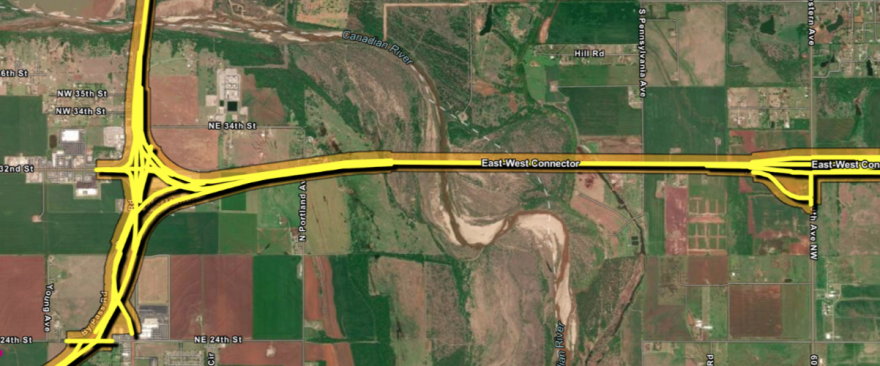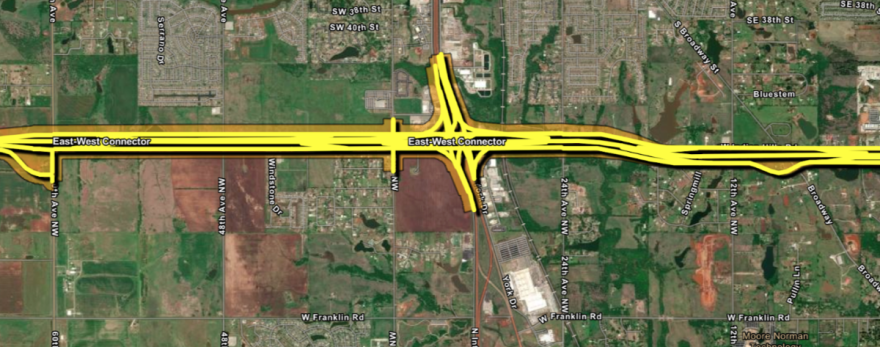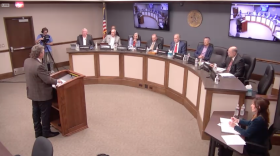The Norman City Council discussed current and future turnpike construction plans in Norman during its study session meeting Tuesday.
In 2022, the Oklahoma Turnpike Authority, or OTA, unveiled the ACCESS Oklahoma project, aiming to improve the state’s turnpike system. The project proposed three new turnpike routes: the South Extension and the East-West Connector, which would greatly affect Norman, and the Tri-City Connector.
In August 2023, the Oklahoma Supreme Court approved the Oklahoma Department of Transportation’s $5 billion, 15-year turnpike expansion plan, allowing the ACCESS Oklahoma project to proceed.



The construction project has raised concerns for Norman leaders and community members, who were present at City Hall before and during the study session to voice their opinions about the turnpikes.
On July 15, the Oklahoma Turnpike Authority requested a meeting with city staff, including City Manager Darrel Pyle, Assistant City Manager Shannon Stevenson and Capital Projects Engineer Scott Sturtz, to discuss the ACCESS Oklahoma project in Norman.
During the study session meeting, Sturtz said phase 1 of the East-West connector is currently underway.
The East-West connector would stretch across I-44, I-35 and the Kickapoo turnpike. It would start in Newcastle and is set to end slightly past Norman city limits. The turnpike would mainly follow Indian Hills Road in Norman until it begins curving north to follow Kickapoo.
Additionally, Sturtz said the connector from Newcastle to Norman will be the longest bridge in Oklahoma, spanning 7,000 feet as it would extend to include train tracks and floodplains, but will not accommodate stormwater runoff. He said the OTA also plans to construct a five-level bridge where I-35 crosses Indian Hills Road and compared it to the George W. Bush Turnpike in Dallas.
The maps shown during the study session meeting, also available on the ACCESS Oklahoma website, use color coding to represent different stages of the project, with yellow indicating active designs and blue signifying future designs.
Pyle emphasized the importance of the construction plans reaching 60% completion, noting that once this milestone is achieved, the city council has no authority to make changes. Any alterations after this point would require funding from the city.
“This is happening. It's only a matter of figuring out alignment,” Pyle said. “It’s in the $5 billion bond package, every blue line, yellow line, orange line you saw, has been approved by the state Supreme Court to happen along with the funding.”
During the study session meeting, Sturtz said the timeline for the East-West connector would be:
- Currently in the works: Environmental studies underway for water bodies, wetlands, threatened and endangered species, historic cultural resources and archaeological cultural resources.
- Fall 2024: 60% of plans to be completed
- Mid 2025: Final plans
- Late 2025: Begin construction
- End of 2027: Mainline open to traffic
During the meeting, Sturtz presented the OTA’s resolution to the councilmembers, calling for a partnership between the OTA and the council, but the majority disagreed with it.
Ward 6 Councilmember Joshua Hinkle and Ward 7 Councilmember Stephen Tyler Holman asked for this language to be removed from the official resolution. They argued that no genuine partnership had existed during the process and criticized the OTA for being difficult to work with.
Holman criticized the OTA for its lack of collaboration with the city council, accusing the authority of ignoring community concerns. He said the OTA's actions have left Norman residents anxious about the potential impact of the turnpike on their homes and further questioned the benefits of the East-West connector.
“I'm just apprehensive about the effort of working with them when it's been shown from day one that they have made no effort at all to work with us and our community,” Holman said.
Ward 5 Councilmember Michael Nash presented his own resolution and asked the council to consider it carefully when deciding what is best for the city.
“Every single one of us has an obligation to fulfill the will of the people we represent,” Nash said.
OTA’s construction plans are set to pass through city floodplains, the Lake Thunderbird watershed and additional areas along the Canadian River corridor. Nash’s resolution would require the OTA to present alternative routes, avoiding these areas.
Pike Off OTA, a grassroots organization against ACCESS Oklahoma, held a press conference before the Tuesday study session meeting. Members of the organization showed support for Nash’s resolution against the planned turnpike expansion through the city's water sources.
“I'm here to ask the city of Norman to support the resolution to protect our water, to take every action available in their power, to slow down and stop the dang Turnpike,” Pike Off OTA member Darla LeBlanc said.
At the press conference, Dave Moore, founder of the Internet Safety Group, distributed media packets that included a spreadsheet detailing all the Department of Environmental Quality violations by the OTA.
During the press conference, former Ward 6 Councilmember Elizabeth Foreman told OU Daily that councilmembers and members of the community were excluded from this conversation.
“When I was on council and we first received the notification, it was a complete shock,” Foreman told OU Daily. “The biggest concern were the closed door meetings, especially with (Mayor Larry Heikkila) discussing details and trying to smooth out maintenance, even though it is a far cry from what council and the public wants.”
Nash also expressed frustration over the lack of communication between city staff and councilmembers.
“All of these secret meetings that staff have had without even informing the council ... I think even (Heikkila) had some meetings with the OTA,” Nash said at the press conference.
During the meeting, Heikkila acknowledged having had a meeting with the OTA early in the discussions without involving the council.
Pyle expressed the difficulties of including the council in the beginning stages of discussion.
“It would be very difficult to not violate the Open Meetings Act and still have council members participate,” Pyle said.
Ward 2 Councilmember Matthew Peacock proposed that the council revisit the discussion once a new hybrid resolution is developed — one that addresses both Nash’s concerns and the interests of the community he represents, as well as the OTA's priorities.
The council will revisit the discussion on Aug. 13.
This story was edited by Ana Barboza. Avery Avery copy edited this story.
This <i>article</i> was originally published by <i>OU Daily</i>.








